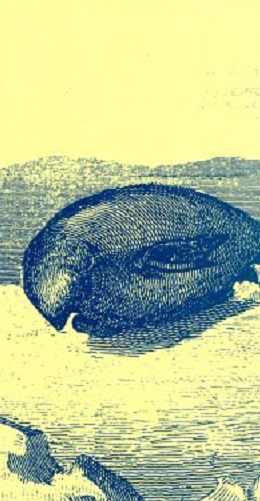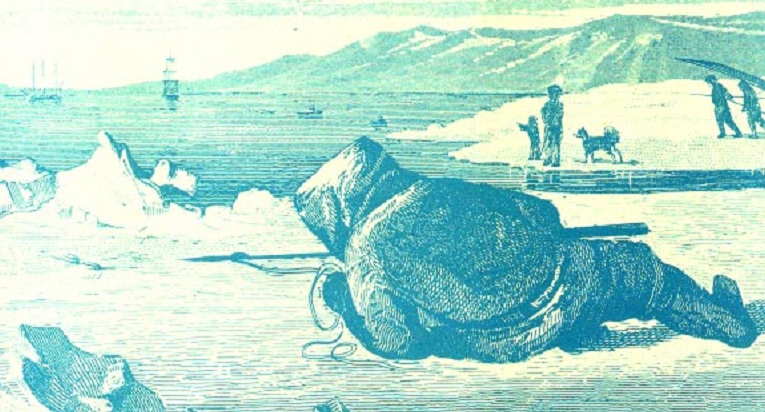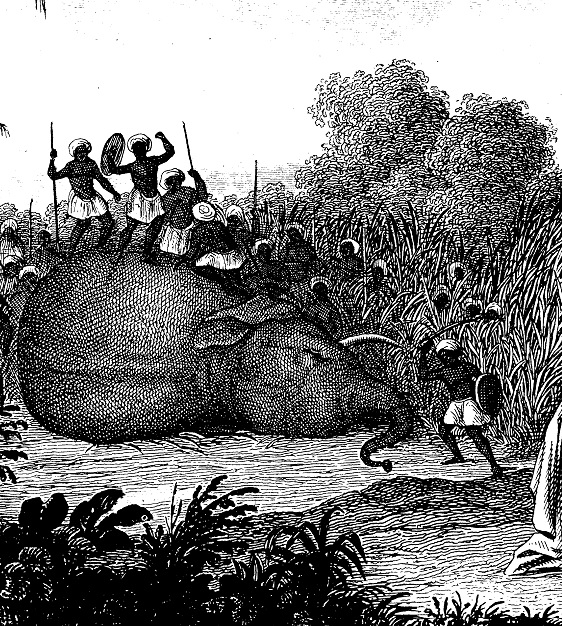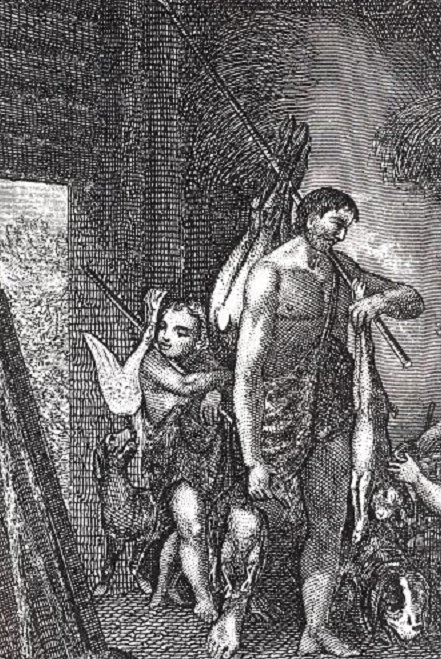Prada the Hunter (hobbit guide)
A detailed hunting system for the AD&D® game
by David Howery
| Hunting Procedure | Antelope | Bison | Giraffe | Hart |
| Musk-Ox | Okapi | Seal | Tapir | Walrus |
| Dragon 137 | - | - | - | Dragon |
T h e Wilderness Survival Guide
contains
fairly complete rules on weather, climate,
and survival in the wilderness. While the
hunting system works well in determining
if the party finds game or not, the rules
for killing game are oversimplified. DMs
who want to skim over the wilderness
trek will find the present rules work fine.
However, some DMs prefer to make the
PCs work harder for their meals and thus
use the normal AD&D game combat
rules.
This article presents a revised hunting
system. The tables herein show exactly
which animals are encountered, depending on the local terrain. Also,
the hunting
proficiency has been modified for these
variant rules.
One important assumption made here is
that the PCs have European or American
tastes in food, and so prefer to eat only
certain types of creatures, like cattle, deer,
etc. PCs could, of course, eat all manner of
things in a pinch, including insect larvae,
lizards, locusts, and monkeys, but it is
assumed they are looking for food the
players themselves would consider.
Prada the Hunter (hobbit guide)
H u n t i n g p r o c e d u r e
If the PCs decide to spend time hunting,
use Table 31 in the WSG
(page 55) to determine whether or not they find game,
using the modifiers given as applicable. If
the dice roll indicates that game is found,
use Tables la to 3c herein to determine
which animals are found. Table 4 is used
in Pleistocene (Stone Age or Ice Age) settings as an alternative to
the encounter
tables in the article "In the Age of Mammals,"
in this issue. The Pleistocene table
herein is properly used only in arctic to
temperate climates, since tropical settings
differed little from those of modern times
during that period.
In addition, the DM should also roll for a
normal random encounter check (1-in-6
chance) for each group of hunters, since
the PCs are wandering around in the
wilderness. If a random encounter is indicated, use the tables
in the back of the
Monster Manual II and roll 1d6 to see
when the encounter occurs, using Table 5
herein.
Once the PCs finally find game, the DM
must check for surprise. Wild animals
have extremely keen senses, particularly
those species that hunt, so it is very difficult for the average person
to surprise
them. Under normal circumstances, there
is a 90% chance that the animal encountered will be aware of the hunters;
this
chance is adjusted as shown on Table 6.
Roll for surprise for the PCs under the
normal surprise rules. Once surprise is
determined, Table 7 is used to determine
how far away the animals are when seen.
As a final note, several animals listed in
the tables herein have equivalents in the
two Monster Manuals. They are listed in
Table 8.
In all of the tables, the small-game listing
includes such mammals as rabbits, hares,
squirrels, and ground hogs. In tropical
areas, this category also includes mouse
deer and capybaras. All such creatures
can be killed with one blow. They have an
armor class of 7 if not moving and 5 if
running. PCs with hunting proficiencies
treat these armor classes as AC 8 and 6,
respectively; this is due to the advantage
that experience gives in hunting small
animals. If surprised, these animals run
panic-stricken until the hunters are out of
sight. If not surprised, there is a 40%
chance that they run only 11-20 yards,
then stop and watch the hunters, allowing
set shots.
Game birds include small-size birds like
ducks, geese, grouse, bustards,
ptarmigans,
pheasants, and partridges. These are
AC 8 on the ground and AC 5 in the air.
PCs with the hunting proficiency treat
these birds as AC 9 and AC 6, respectively.
If surprised, the birds are seen on the
ground. If not themselves surprised, the
PCs have time for one shot before the
birds take to the air. If not surprised, the
birds suddenly burst into the air and
streak away from the hunters. Once airborne, the birds move out of
missile range
in one round.
Other game animals are extremely wary.
If not surprised, game animals keep at
least 50 yards between themselves and the
hunters. If the hunters move directly
toward the animals or kill one of them, the
animals run away from the hunters at full
speed for 3-5 rounds.
Obviously, only a few weapons are useful for hunting game; bows are
the best.
Crossbows, slings, and atlatl-launched
javelins are also useful. Hurled weapons
(spears, daggers, etc.) either have ranges
too short or do too little damage to be of
much help. Swords and other hand-held
weapons are useless when facing wary
animals that won't let PCs get close.
Use the normal game combat rules to
determine the characters' success in bringing down any of these creatures.
Most
animals move away from the hunters if
attacked, unless otherwise noted.

Most creatures herein have the following common statistics:
% IN LAIR: Nil (free roaming)
TREASURE TYPE: Nil
SPECIAL ATTACKS: Nil
SPECIAL DEFENSES: Nil
MAGIC RESISTANCE: Standard
INTELLIGENCE: Animal
ALIGNMENT: Neutral
SIZE: L
PSIONIC ABILITY: Nil
LEVEL/XP VALUE: See the DMG, page
85.
SOURCE: "What's For Lunch?", Dragon 137.
Table 1a
Arctic and Subarctic Zone Encounters
| 1d100 | Forest | Hills or Mountains |
| 01-05 | Black bear (1-2) 12 | Dall sheep (2-5) |
| 06-10 | Brown bear (1-2) 12 | Dall sheep (2-5) |
| 11-60 | Game bird (1-6) | Small game (1-4) |
| 61-70 | Small game (1-4) | Game bird (1-6) |
| 71-80 | Musk-ox (2-8) 1 | Game bird (1-6) |
| 81-90 | Caribou (2-12) | Goat, mountain (1-6) |
| 91-95 | Hart (1-4) | Goat, mountain (1-6) |
| 96-00 | Moose (1-2) 1 | Bighorn sheep (2-5) |
1 If wounded, these animals are 80% likely to charge and
attack a random hunter.
2 In winter months, replace bears with small game.
Table 1b
Arctic and Subarctic Zone Encounters
| 1d100 | Plains | Seacoast |
| 01-05 | Musk-ox (3-30) 1 | Brown bear (1-2) 12 |
| 06-10 | Musk-ox (3-30) 1 | Polar bear(1-2) 12 |
| 11-40 | Small game (1-4) | Game bird (1-6) |
| 41-60 | Small game (1-4) | Small game (1-4) |
| 61-70 | Game bird (1-6) | Seal, small (4-16) |
| 71-80 | Game bird (1-6) | Seal, medium (3-12) |
| 81-90 | Caribou (4-40) | Seal, large (3-12) |
| 91-95 | Caribou (4-40) | Walrus (4-16) 1 |
| 96-00 | Caribou (4-40) | Roll on appropriate inland terrain list |
1 If wounded, these animals are 80% likely to charge and
attack a random hunter.
2 In winter months, replace bears with small game.

Table 2a
Temperate Zone Encounters
| Dice | Forest | Hills/Mountains |
| 01-05 | Black bear (1-2) 2 | Bighorn sheep (2-5) |
| 06-09 | Brown bear (1-2) 2 | Bighorn sheep (2-5) |
| 10-13 | Bison (3-6) 1 | Ibex (2-5) |
| 13-25 | Boar (1-3) 1 | Wapiti (3-24) |
| 26-30 | Wild cattle (2-7) 1 | Goat, mountain (2-5) |
| 31 | Clubnek (1-4) 1 | Yak (5-8) 1 |
| 32-50 | Game bird (1-6) | Small game (1-4) |
| 51-70 | Small game (1-4) | Small game (1-4) |
| 71-85 | Hart (2-5) | Game bird (1-6) |
| 86-95 | Red deer (1-4) | Black bear (1-2) 2 |
| 96-00 | Moose (1-3) | Hart (4-16) |
1 If wounded, these animals are 80% likely to charge and
attack a random hunter.
2 In winter months, replace bears with small game.
Table 2b
Temperate Zone Encounters
| Dice | Desert | Plains |
| 01-05 | Hart (1-4) | Grizzly bear (1-2) 2 |
| 06-13 | Peccary (1-8) 1 | Bison (5-50) 1 |
| 14-25 | Antelope, small (3-12) | Bison (5-50) 1 |
| 26-30 | Antelope, small (3-12) | Antelope, medium (2-20) |
| 31 | Small game (1-4) | Antelope, medium (2-20) |
| 32-50 | Small game (1-4) | Small game (1-4) |
| 51-70 | Game bird (1-6) | Game bird (1-6) |
| 71-85 | Camel (2-8) | Game bird (1-6) |
| 86-95 | Camel (2-8) | Antelope, small (3-30) |
| 96-00 | Desert bighorn (1-4) | Wild cattle (2-40) 1 |
1 If wounded, these animals are 80% likely to charge and
attack a random hunter.
2 In winter months, replace bears with small game.
Table 2c
Temperate Zone Encounters
| Dice | Swamp | Seacoast |
| 01-05 | Black bear (1-2) 2 | Seal, small (4-16) |
| 06-09 | Bunyip (1) 1 | Seal, medium (4-16) |
| 10-13 | Crayfish, giant (1-2) 1 | Seal, medium (4-16) |
| 14-25 | Crane, giant (1-2) 1 | Seal, medium (4-16) |
| 26-30 | Crane, giant (1-2) 1 | Seal, large (3-12) |
| 31 | Boobrie (1-2) 1 | Crab, giant (1-3) 1 |
| 32-70 | Game bird (1-6) | Game bird (1-6) |
| 71-95 | Small game (1-4) | Small game (1-4) |
| 96-00 | Swan (2-5) | Roll on appropriate inland terrain list |
1 If wounded, these animals are 80% likely to charge and
attack a random hunter.
2 In winter months, replace bears with small game.
Table 3a
Tropical/
Subtropical Zone Encounters
| Dice | Forest/Jungle | Hills/Mountains |
| 01-10 | Black bear (1-2) 1 | Goat (2-8) |
| 11-20 | Boar, warthog (2-5) 1 | Goat (2-8) |
| 21-30 | Buffalo (2-8) 1 | Goat (2-8) |
| 31-66 | Small game (1-4) | Small game (1-4) |
| 67-87 | Game bird (1-6) | Game bird (1-6) |
| 88-94 | Antelope, small (2-8) | Game bird (1-6) |
| 95-96 | Okapi (1-4) | Antelope, small (1-6) |
| 97-98 | Rhinoceros, 8 HD (1-4) 1 | Antelope, small (1-6) |
| 99-00 | Rhinoceros, 9 HD (1-4) 1 | Antelope, small (1-6) |
1 If wounded, these animals are 80% likely to charge and attack a random hunter.
Table 3b
Tropical/
Subtropical Zone Encounters
| Dice | Desert | Plains |
| 01-10 | Antelope, small (1-8) | Antelope, small (3-30) |
| 11-20 | Antelope, small (1-8) | Antelope, medium (4-40) |
| 21-25 | Camel (2-8) | Antelope, large (2-40) 1 |
| 26-30 | Camel (2-8) | Boar, warthog (2-5) 1 |
| 31-40 | Small game (1-4) | Buffalo (4-16) 1 |
| 41-45 | Small game (1-4) | Giraffe (3-12) |
| 46-66 | Small game (1-4) | Game bird (1-6) |
| 67-87 | Game bird (1-6) | Small game (1-4) |
| 88-90 | Game bird (1-6) | Flightless bird, ostrich (2-8) |
| 91-94 | Antelope, medium (1-8) | Flightless bird, emu (2-8) |
| 95-96 | Antelope, medium (1-8) | Flightless bird, rhea (3-12) |
| 97-98 | Flightless bird, ostrich (2-8) | Rhinoceros 8 HD (1-8) 1 |
| 99-00 | Flightless bird, ostrich (2-8) | Rhinoceros: 9 HD (1-8) 1 |
1 If wounded, these animals are 80% likely to charge and
attack a random hunter.
Table 3c
T r o p i c a l / S u b t r o p i c a l Z o n e
E n c o u n t e r s
| D i c e | Swamp | Seacoast |
| 01-10 | Buffalo (2-5) 1 | Crab, giant (1-3) 1 |
| 11-20 | Buffalo (2-5) 1 | Crab, giant (1-3) 1 |
| 21-25 | Tapir (1-4) | Crab, giant (1-3) 1 |
| 26-40 | Tapir (1-4) | Small game (1-4) |
| 41-45 | Game bird (1-6) | Small game (1-4) |
| 46-87 | Game bird (1-6) | Game bird (1-6) |
| 88-90 | Small game (1-4) | Game bird (1-6) |
| 91-94 | Small game (1-4) | Seal, elephant (3-9) 1 |
| 95-96 | Crayfish, giant (1-3) 1 | Seal, elephant (3-9) 1 |
| 97-98 | Crayfish, giant (1-3) 1 | Turtle, giant sea (1-4) |
| 99-00 | Turtle, giant snapping (1) 1 | Roll on appropriate inland terrain list |
1 If wounded, these animals are 80% likely to charge and attack a random hunter.

T a b l e 4
P l e i s t o c e n e E p o c h E n c o
u n t e r s
(All Terrain, Arctic to Temperate)
| D i c e | G a m e |
| 01-10 | Axebeak (1-2) 1 |
| 11-20 | Cave bear (1-2) 2 |
| 21-30 | Boar, giant (1-6) 1 |
| 31-40 | Irish deer (1-4) 1 |
| 41-50 | Mammoth (2-20) 1 |
| 51-60 | Mastodon (2-20) 1 |
| 61-70 | Wooly rhinoceros (1-6) 1 |
| 71-75 | Phororhacos (1) 1 |
| 76-00 | Roll on appropriate modern terrain/climate list |
1 If wounded, these animals are 80% likely to charge and
attack a random hunter.
2 In winter months, replace bears with small game.

T a b l e 5
T i m i n g o f W i l d e r n e s s
E n c o u n t e r s W h i l e H u n t i n g
| 1 d 6 | W hen wilderness encounter occurs |
| 1 - 2 | 1d4 turns before the hunting encounter |
| 3 | Simultaneous with the hunting encounter |
| 4-6 | 1d4 turns after the hunting encounter |
Table 6
Modifications to Surprise
| Condition | Modifier |
| A l l h u n t e r s i n t h e g r o u p a r e i n v i s i b l e : | - 2 0 % |
| A l l h u n t e r s i n t h e g r o u p a r e s i l e n c e d : | - 2 0 % |
| A l l h u n t e r s i n t h e g r o u p a r e o d o r l e s s : | - 2 0 % |
| A l l h u n t e r s i n g r o u p h a v e h u n t i n g p r o f i c i e n c y : | - 2 5 % |
Table 7
Distance Between Hunters and Quarry
| Game | Animal surprised | Animal not surprised |
| Small game | 5-20 yards | 11-30 yards |
| Game bird | 5-20 yards | 21-40 yards |
| Other game | 10-40 yards | 50-80 yards |
Table 8
Animal Conversions
| Animal
encountered |
AD&D® game
equivalent |
| Caribou, red deer, wapiti | Stag |
| Dall sheep, desert bighorn | Ram |
| Ibex | Goat, giant |
| Moose | Stag, giant |
| Mountain goat | Goat |
| Peccary | Boar |
| Yak | Buffalo |
ANTELOPE +
BISON +
GIRAFFE +
HART +
MUSK-OX +
OKAPI +
SEAL +
TAPIR +
WALRUS +